Yamaha’s 2009 model big-bang YZF-R1 has shot into the market, taking down all in its way. MotoOnline.com.au brings you the first Aussie test on the web.
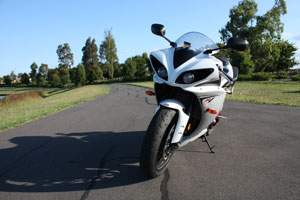
SPECIFICATIONS
ENGINE
Engine type: Liquid-cooled, 4-stroke, DOHC, 4-valve, forward-inclined parallel 4-cylinder
Bore x stroke: 78.0 x 52.2mm
Displacement: 998cc
Compression ratio: 12.7:1
Transmission: Six speed
Power (claimed): 180hp
Torque (claimed): 86ft-lbs
CHASSIS
Frame type: Aluminium Deltabox
Front suspension: Fully-adjustable 43mm inverted Soqi fork
Rear suspension: Fully-adjustable Soqi shock absorber
Wheelbase: 1415mm
Wheels (type/front/rear): Five spoke aluminium alloy / 3.5 x 17 / 6 x 17
Tyres (front/rear): 120/70 ZR17MC(58W) / 190/55 ZR17MC(75W)
Brakes (front/rear): 310mm dual discs, six piston radially mounted calipers / 220mm single disc
DIMENSIONS
Weight (claimed): 206kg (wet)
Seat height: 835mm
Fuel capacity: 18L
PURCHASE DETAILS
Price: $19,999 + orc
Colour options: Yamaha Blue, Competition White or Midnight Black
Test bike from: Yamaha Motor Australia
There’s been a heck of a lot of hype about this year’s big-bang Yamaha YZF-R1, and for good reason. By taking technology from Valentino Rossi’s factory MotoGP bike and bringing it to the streets, Yamaha has made one of the most revolutionary engine steps in 1000cc sportsbike development since the original R1’s inception back in 1998.
The new race-developed crossplane crankshaft, which fires in uneven intervals at 270-180-90-180 degrees, offers torque like we’ve never experienced before on any four-cylinder sportsbike, providing a big-bang engine configuration similar to that on the YZR-M1 MotoGP bikes.
While Yamaha claims a power increase of just three horsepower from 177hp in 2008 to 180hp this year, the 86ft-lbs of torque is the talking point of the new R1 – up three from last year’s conventional firing R1.
After reading the world launch reports from Eastern Creek back in February, we all knew that the 998cc, liquid-cooled, four-stroke, DOHC, four-valve, inline four-cylinder engine would be a blast out on the open roads of the real world.
And that’s exactly where the majority of this test is taking place as I look to sample the ins and outs of the Yamaha on the public roads while it’s in my hands for a couple of weeks.
If you don’t fall in love with the R1 at first sight, you’ll be sure to become fonder of it as soon as the key is turned and the engine start button is pressed. The engine noise is deep and strong, with a twist of the throttle creating a quick and very individual bark. There’s no other sportsbike on the market that sounds like the new R1.
Some compare its sound to a twin-cylinder, while others compare it to a triple, but the truth is that it has a very unique sound that actually somewhat mimics the note released from the exhausts of Rossi and his fellow Yamaha MotoGP counterparts’ bikes.
It’s obviously not as loud, but the droning output from the 4-2-1-2 exhaust system is very much reminiscent of when I was lucky enough to ride Rossi’s M1 at Valencia, Spain, in 2007.
As soon as I begin to roam around the streets putting as many kays on the bike as time permits in my dance with destiny, each biker that I come across almost snaps their neck in the urge to check out exactly what that thumping noise is coming out of the Japanese litre bike.
If Yamaha Racing Team Australian 1000cc Superstock rider Pat Medcalf’s R1 is anything to go by (not to mention Ben Spies’ factory WSBK racer), bolting on a set of aftermarket exhausts is the way to go for a throatier note that sounds even tougher than an Anthony Mundine interview on the eve of a boxing match.
Moving on to the engine’s performance, its quick-revving characteristics I noticed while at a standstill are very much confirmed as soon as I power out of the first set of bends I encounter at speed.
Yamaha prides itself off of the connection between the rider’s throttle hand and the engine’s output to the rear tyre, and I’d have to agree that this aspect of the big-bang firing order is the ultimate advantage that the Yamaha gains through its crossplane technology.
Whether I’m chugging along a straight piece of road in top gear or powering out of a bend hard in second, the throttle response is undoubtedly a great step forward from any other four-cylinder that I’ve ridden.
I should clarify that statement by saying that the response is great in the Yamaha D-mode’s Standard setting, which is what the bike automatically starts with when firing the engine into life.
The track-focussed A-mode is the all-out power option, which is a real buzz once applied and offers a massive increase of power that you can feel through the seat of your pants, although the response isn’t smooth by any means. It’s fierce and aggressive, most likely best suited for sticky rubber on race tracks.
B-mode is the least powerful of the three and still offers a decent amount of usable power, although if you’re purchasing an R1 for the sheer thrill of the ride then it’s highly unlikely that you’ll find yourself switching to the B-mode.
The Standard mode is where I leave the Yamaha D-mode selector more often than not, mainly because it offers a usable bout of power throughout the range and is not only smooth off the bottom, but also fast enough up top.
All three settings are adjusted by a flick of a switch on the right handlebar, proving both easy and effective whether you’re riding along at speed or at a standstill. Come to think of it, the position of all the controls are in very easy to reach positions, providing maximum comfort and safety so you can concentrate on your riding rather than feeling around for the controls.
Powering through this one set of uphill twisties, I take them in third gear first time around and find myself revving the engine gracefully as I accelerate from one corner to the next.
I decide to turn around and attempt them set of turns in second gear for good measure, again powering through the corners and up the hill with even more torque and the same great throttle response.
It’s after I go back once again and take the set of turns in fourth gear just to see how the engine would handle it that I realise just how capable and user friendly the big-bang concept is – the engine has absolutely no hesitation or protest in fourth gear either.
And that scenario isn’t just a one-off coincidence on a single set of bends. Often I find myself rolling through corners and powering out of them in high or low gears, enjoying the balance and forgiveness of the torquey engine.
I find myself shifting less and using the power of the engine more than what I ever did on the previous incarnation of the R1, with corners that were critical to take in second gear before now becoming a walk in the park as I leave the engine in third and use the torque to its full advantage on exit.
When cruising on open sections of roads I find myself mostly shifting between fourth and fifth gears in the six-speed gearbox, not really needing sixth when cruising on the maximum speed limits apart from the 110km/h areas on freeways. In fact, I find using sixth on a lot of roads a little bit over-geared and prefer the extra response of fifth gear, even if it is only a subtle difference.
The gearbox is seamless in its shifts and offers great response to each nudge, although the gearing’s high setting in standard trim means that it requires a good amount of revs to comfortably start from a standstill, especially at uphill traffic lights.
The powerband is solid throughout the range and it begins to come on at 4000rpm before gaining steam at around 6000rpm, really hitting hard when it moves past 8500rpm all the way to the shift point that I find necessary at around 12,000-12,500rpm.
Red markers on the dash at 13,500rpm to its maximum reading of 15,000rpm indicate that it can be revved up to around 13,000rpm, but my feeling from the saddle is that power begins to drop at around 12,000rpm (without seeing the dyno charts).
Short shifting is a very common occurrence for me on the new R1 and I find myself using the torque and then kicking it up another gear for the next load of torque, never really screaming the power past 9000rpm when on the public streets. Places where I would have had to really rev last year’s model see me punching through them with ease on this year’s big-bang version.
The engine’s reaction when downshifting back through the gears into corners also makes it very forgiving for the rider, with the slipper clutch giving feedback very much like that of the R6’s. It floats through the gears as you downshift, with the rear tyre slightly locking if you happen to do it a little quickly, although it’s always a smooth transition as the slipper does its job thoroughly.
Fuel economy with the big-bang engine configuration is actually pretty good, coming in at 6.7L/100km following a couple of long rides at a moderate pace to give a fair indication of its consumption. Fuel consumption (real time and average) indicators on the dash are also provided, with its average turning out pretty similar to my calculations.
Speaking of the dash, it’s simple and easy to read, featuring a large tachometer and adjustable shift light, plus all the usual lights including indicators, fuel, neutral, high beam, oil, water, immobilizer indicator, and engine trouble.
There are three digital boxes, and the one which features the speedo also has two trip metres, a reserve fuel kilometre indicator when you’re running low, the time, lap time with memory, and the fuel consumption features mentioned above.
Another box has the unique throttle opening indicator along with the engine temperature and D-mode indicator, while an R1 logo adds a nice touch.
The final digital box features the gear indicator, which comes in very handy as you learn the ropes of the crossplane powerplant.
While it’s quite a busy display, it’s easy to use with just two buttons (select and reset), and it’s all easy enough to read while on the move, which is the main thing. I would have liked to see a digital fuel gauge, though.
As impressive as the engine is on the R1, handling hasn’t been overlooked with the bike featuring a new Deltabox frame that has a changed rigidity balance that flexes more, theoretically offering more feedback to the rider. The torsional rigidity is the same, there’s more vertical rigidity, but less lateral rigidity. What this does is offer more high-speed stability and better traction off the turns, according to Yamaha engineers.
The subframe is direct from the R6, while having the engine nine degrees closer to vertical and 8.2mm further forward than last year shifts the weight bias toward the front of the bike half a percent. The lighter swingarm’s length remains the same, but the pivot point is located closer to the countershaft sprocket. All of these changes are essentially adopted to make the most of the extra torque of the engine, and they do their job just fine.
Handling in the real world is good, while not perfect, and isn’t a massive breakthrough like the engine’s performance – but that would be a massive ask to make those kinds of advancements. While the stability at speed is very good and on par with Yamaha’s hopes, precision when turning into the corners isn’t so refined.
It’s a little difficult to get the initial turning started and I find myself missing my ideal line at times, but once you get it on the right track it holds its line very well and the stability is exceptional. Changing direction is also made quite easy, it’s just that transition from hard braking to corner entry that isn’t quite as good as the likes of Honda’s Fireblade.
The ride-height feels higher in the rear than in previous models (with a higher profile rear tyre size of 55 from 50 aiding this) and it reacts well to small adjustments on your line as you sweep through corners that don’t require hard braking, but it just seems that its weight of 206 kilograms (claimed, wet) makes it slightly difficult to pull up and put it on your preferred line in a hurry – especially on the race track.
In saying that, the fully-adjustable 43mm inverted Soqi fork is very controlled under heavy braking, and its added adjustability of having separate compression adjustment in the left fork leg and rebound only in the right does offer very precise adjustments that you can feel when fine-tuning the suspension.
At one point I find the bike wants to bounce off line mid-corner on a particularly bumpy road, but a couple of clicks to slow down the rebound to help the fork stay down in the stroke does the trick. The adjustment is very precise, as are the compression changes when I adjust it to feel its sensitivity.
The pair of six-piston front brake calipers that clamp the pads to the 310mm discs are very worthy of an applause as they offer massive amounts of stopping power when the lever’s squeezed, and the discs are actually lighter in the new model. The master-cylinder is slightly different in the angle that the lever pushes the piston, and I’d say that the brake lever feel is slightly better than previous models.
A 220mm disc provides adequate feel in rear braking, although the Dunlop D210 Qualifier tyres fitted to the bike standard mean that you have to be very light on the foot lever so you don’t lock the rear tyre on corner entry. In fact, stickier tyres would probably make a world of difference to the bike’s overall handling at speed.
Once through the entry and mid-corner, accelerating out is the strong point thanks to both the engine and the chassis, with the fully-adjustable Soqi shock absorber accepting all the throttle application that you dare. On corner exit the bike holds its line well and doesn’t squat in the rear and run wide, simply allowing you to power out of the turns at your convenience.
Again, the engine is a true advantage in this area, because the feeling that you get when twisting the throttle is applicably matched by the rear suspension, even allowing you to find that nice balance of grip and a slight drift of the rear wheel when under hard acceleration.
Overall, the package of the 2009 model Yamaha YZF-R1 is going to be a hard one to top when it comes time for AMCN’s AUStest track and road comparos. The engine is not only very competitive, but very enjoyable to ride no matter if you’re looking for outright speed or a cruisy Sunday ride, while the chassis is an improvement over previous R1s in many ways.
The best part about the R1 is that it brings a smile to your face every time you crack the throttle open and listen to the big-bang engine roar – and having a good time is what motorcycling is all about.
COSMETIC FUNCTIONALITY
Love it or hate it, Yamaha’s 2009 YZF-R1 has its own individual styling that is somewhat reminiscent to older model R1s, but also stands out in a crowd with its own particular identity.
Coming in three different colour options (Yamaha Blue, Competition White, and Midnight Black), the R1 bucks the trend of slimline sportsbikes and features a more chunky body appearance – not least with the large triangular under-seat mufflers.
One bonus is that the wide pillion seat offers decent storage underneath and a pretty large surface to strap baggage on to, although I didn’t have a pillion to get their opinion on whether the exhausts affect their seating position at all.
The R1 features a redesigned forced air intake system that utilises the natural airflow to increase the pressure in the airbox, which adds power at high-speed. The intake system features as part of the bumblebee light surroundings, and then it’s channelled via the left and right sides of the new frame directly into the airbox.
A fault with the airflow and the undertail exhausts is that the heat gets excruciatingly hot on warm days, especially in traffic when stopped at lights. Riding in leathers on the circuit at speed is warm, but riding in Draggin’ Jeans on the street causes uncomfortable heat build up around the legs.
On a positive note, mirrors are quite long, but their functionality is very good and offer rear view better than any other bike in its class. Only minimal elbow movement is required to see exactly what’s behind you.
TRACK TESTED
Taking the R1 out for a day at Eastern Creek gave us a true indication of the engine’s performance. Early indications are that the engine’s torque is the highlight on track as it is in the real world. Its feedback allows you to get aggressive with the throttle and feel every inch that the tyre may want to slide, with the feel being a major improvement over previous models all the way through the range.
Top speed isn’t a standout, although the way it jumps out of corners will more than make up for any shortfall in top speed – just look at Ben Spies’ performance in world Superbike at Qatar. It’s not slow by any means, but the rush at the end of the straight isn’t as big as the Suzuki or Kawasaki litre bikes.
Handling is very similar to what we felt on the road, with initial turn-in proving a little tricky to get it on your exact chosen line, but once turned in it holds its line very well and its suspension feel is a great match for the throttle response. Sticker tyres would make the ride that much more enjoyable, though, which would really allow the bike to be pushed to a whole new level on the race track.


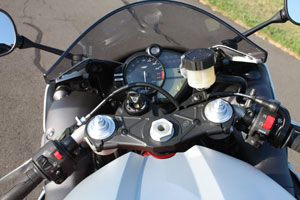
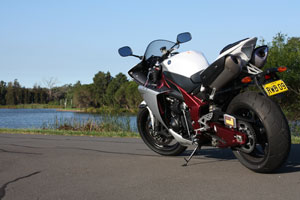
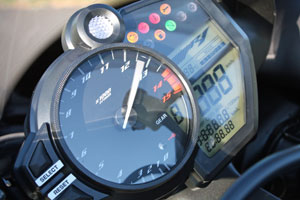
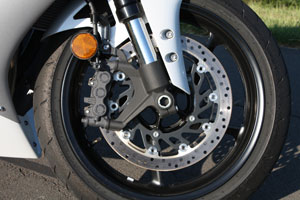
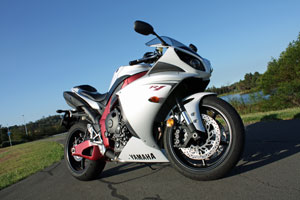
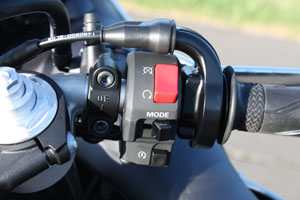





Newsletter